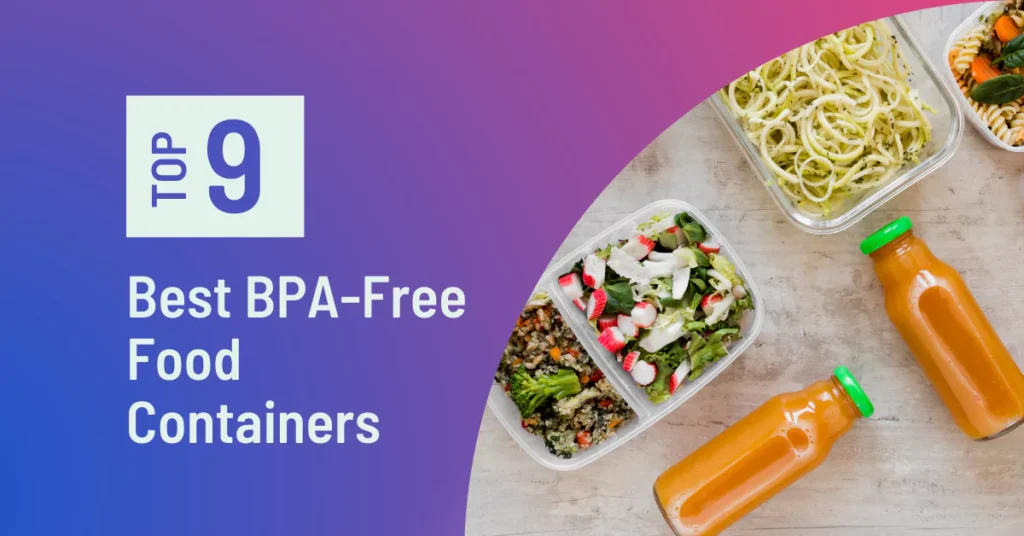Have you ever heard of BPA? It stands for bisphenol A, a chemical compound used to produce certain plastics, including food containers and water bottles. Here’s the thing about BPA – while it’s great for making plastics sturdy and resilient, there’s been growing concern about its safety
You see, over time, BPA can leach out of plastic containers, especially when heated or exposed to acidic foods or beverages. And that’s where the worry comes in. Some studies suggest that BPA might mimic hormones in the body, potentially leading to health issues like hormone disruption, reproductive problems, and even certain cancers. Yikes, right?
But fear not! The good news is that there’s been a surge in BPA-free alternatives flooding the market. These containers are made without BPA, offering a safer option for storing your favourite foods and drinks.
In this blog, we’ll give you the lowdown on BPA-free food containers. We’ll cover their benefits, what to look for when choosing the right ones, and share our top picks for the best BPA-free containers. So, stay tuned – find the perfect container to keep your meals fresh and healthy!
What is BPA?
BPA or Bisphenol-A. BPA is a chemical compound used primarily in the production of clear and rigid plastics. It’s known for its ability to make plastic strong and durable, which is why you often find it in products like water bottles, food containers, and even household items like toys and electronics.
BPA plays a crucial role in creating these types of plastics because it helps to bind the molecules together, forming a sturdy structure that can withstand everyday use. This is why you’ll often see it labelled on plastic products with the recycling symbol and the number 7.
While BPA has been widely used for decades, there’s been growing concern about its potential health effects. Studies have suggested that BPA can leach into food and beverages from containers, especially when they’re heated or exposed to acidic substances. And because BPA can mimic the hormone estrogen in the body, there’s worry that it could disrupt normal hormone function and potentially lead to various health issues.
So, while BPA has been a key player in creating many of the plastic products we use daily, its potential health risks have led to the rise of BPA-free alternatives in the market. These alternatives aim to provide safer options for storing food and beverages without the worry of BPA exposure.
Why is BPA-Free Necessary?
Why BPA-free is a big deal when it comes to your food containers. You might be wondering, why all the fuss about this BPA stuff? Well, here’s the lowdown:
First off, BPA, short for bisphenol A, has been raising some eyebrows in the health world. You see, it’s been linked to some potential health issues when it leaches into your food from plastic containers. Now, I’m not trying to scare you, but some studies suggest that BPA could mess with your hormones, which is not what you want mingling with your meal prep.
Sure, there’s still some ongoing research trying to nail down exactly how much of a risk BPA poses to us. Scientists are always digging deeper to understand its safety better. But hey, why take chances, right? When you’ve got the option to go BPA-free with your food containers, it just seems like the safer bet.
So, bottom line, opting for BPA-free containers might just give you some extra peace of mind when it comes to your health. And who doesn’t want that?
Is All BPA-free Containers Are Safe?
When something is labelled as “BPA-free,” it simply means that it doesn’t contain Bisphenol A, a chemical commonly found in plastics that has been linked to various health concerns. Now, that sounds like a good thing, right? And it is, but here’s the catch: just because something is BPA-free doesn’t automatically make it completely safe.
You see, while manufacturers have ditched BPA, they sometimes use alternative chemicals to achieve similar effects in their plastics. These alternatives might not have been studied as extensively as BPA, so there’s still some uncertainty about their safety. It’s like trying to avoid one pothole on the road only to encounter another one up ahead!
But don’t worry, it’s not all doom and gloom. Many BPA-free plastics use safer alternatives, like BPS or BPF, which are believed to be less harmful than BPA. However, research is ongoing, and it’s always a good idea to stay informed about any potential risks associated with these chemicals.
So, while going BPA-free is a step in the right direction, it’s essential to stay vigilant and keep an eye out for any new developments in plastic safety. After all, your health is worth it, right?
Types of BPA-Free Plastic for Food Containers
When it comes to choosing BPA-free plastic for your food containers, there are several options available in the market. Each type of plastic has its own set of properties and advantages. Below is a comparison table outlining some common types of BPA-free plastics used in food containers:
| Plastic Type | Description | Pros | Cons |
|---|---|---|---|
| 1. PET (Polyethylene Terephthalate) | PET is lightweight, transparent, and durable. It is commonly used for water and soda bottles. | – Clear and transparent – Lightweight – Resistant to impact and shattering | – Not suitable for microwave or dishwasher use – Can stain and retain odours |
| 2. HDPE (High-Density Polyethylene) | HDPE is a sturdy and versatile plastic. It is widely used for milk jugs, detergent bottles, and food containers. | – Strong and durable – Resistant to chemicals – Recyclable | – Not suitable for microwave or dishwasher use – Can stain and retain odors |
| 3. PP (Polypropylene) | PP is known for its high melting point, making it suitable for use in microwave-safe containers. It is commonly used in yogurt containers, deli soup containers, and reusable food storage containers. | – Microwave and dishwasher safe – Resistant to heat and moisture – Recyclable | – Not as clear as other plastics – Can degrade when exposed to sunlight |
| 4. Tritan™ | PP is known for its high melting point, making it suitable for use in microwave-safe containers. It is commonly used in yoghurt containers, deli soup containers, and reusable food storage containers. | – BPA-free and EA-free – Clear and durable – Dishwasher safe | – Relatively expensive compared to other plastics – Limited recycling options |
| 5. PLA (Polylactic Acid) | PLA is a biodegradable plastic made from renewable resources such as cornstarch or sugarcane. It is commonly used in compostable food containers and packaging. | Tritan™ is a BPA-free plastic known for its clarity, durability, and resistance to stains and odours. It is often used in water bottles, baby bottles, and food storage containers. | – Not suitable for long-term food storage – Limited heat resistance |
Note: While these plastics are marketed as BPA-free, it’s essential to follow manufacturer guidelines for safe use and storage.
Best BPA-free Plastic Type for Food Containers
Each criterion is rated on a scale of 1 to 5, with 5 being the highest score. In the end, the total scores are calculated to determine which plastic type might be considered the best for food containers:
| Criteria | PET | HDPE | PP | Tritan™ | PLA |
|---|---|---|---|---|---|
| Transparency | 4 | 3 | 2 | 5 | 4 |
| Durability | 4 | 5 | 4 | 5 | 3 |
| Resistance to Odors/Flavors | 3 | 3 | 4 | 5 | 4 |
| Microwave Safety | 1 | 1 | 5 | 5 | 3 |
| Dishwasher Safety | 3 | 2 | 5 | 5 | 3 |
| Heat Resistance | 2 | 2 | 4 | 5 | 3 |
| Recyclability | 4 | 5 | 4 | 3 | 5 |
| Environmental Impact | 3 | 4 | 3 | 3 | 5 |
| Total Score | 24 | 25 | 31 | 36 | 30 |
Based on the quantitative comparison, Tritan™ plastic appears to be the best choice for food containers, scoring the highest total score of 36. It excels in various aspects such as transparency, durability, resistance to odours/flavours, microwave and dishwasher safety, heat resistance, and recyclability. However, environmental impact considerations might favour PLA, which scored the second-highest total score of 30 and is biodegradable and compostable.
Top BPA-free Food Containers
Whether you’re packing lunches, storing leftovers, or simply hydrating on the go, having the right containers can make a world of difference. Let’s take a look at some top picks:
BPA-free Food Container
1. Amazon Basics Glass Locking Lids Food Storage Containers
Amazon Basics Glass Food Storage Container with BPA-Free Locking Lid - Set of 14 pieces, clear with blue silicone ring
$31.12 in stock
These containers offer a perfect blend of durability and versatility. Made from high-quality glass, they are free from harmful chemicals like BPA, ensuring your food stays fresh without any health risks. The locking lids provide a secure seal, keeping your food safe and spill-free. Plus, they’re microwave, oven, freezer, and dishwasher safe, making them incredibly convenient for everyday use.
PRO
CONS
2. Chef’s Path Airtight Food Containers with Easy Lock Lids
Chef's Path Airtight Food Storage Containers Set with Lids (24 Pack) for Kitchen and Pantry Organization - BPA Free Kitchen Canisters for Cereal, Rice, Flour & Oats - Free Marker and 24 Labels
If you’re looking for airtight storage solutions, these containers are a fantastic choice. With their easy-lock lids, they create a tight seal that keeps air and moisture out, preserving the freshness of your food for longer periods. Made from BPA-free materials, they’re safe for storing all types of food, from dry goods to leftovers. Their stackable design helps save space in your kitchen cabinets or pantry.
PRO
CONS
3. Rubbermaid Brilliance BPA-Free Food Storage Containers with Lids
Rubbermaid Brilliance BPA Free Food Storage Containers with Lids, Airtight, for Lunch, Meal Prep, and Leftovers, Set of 22
These containers are known for their superior clarity and durability. Made from Tritan plastic, they are resistant to stains and odours, ensuring your food looks and tastes fresh every time. The leak-proof lids feature innovative latches that create a tight seal, preventing spills and leaks. They’re also microwave, dishwasher, and freezer safe, offering ultimate convenience for meal prep and storage. (Full Review)
PRO
CONS
4. Bentgo® Prep 1-Compartment Containers
Bentgo® Prep 1-Compartment Containers - 20-Piece Meal Prep Kit: 10 Trays & 10 Lids - Lightweight, Durable, & Reusable BPA-Free To-Go Food Containers; Microwave/Freezer/Dishwasher Safe (White)
$11.99 in stock
Perfect for meal prepping and portion control, these containers are designed with practicality in mind. The single compartment allows you to portion out your meals easily, making it ideal for lunches on the go or storing leftovers. Made from durable materials free from BPA and other harmful chemicals, they provide a safe and convenient way to store your food.
PRO
CONS
BPA-free Water Bottles
5. Owala FreeSip Insulated Stainless Steel Water Bottle with Straw
Owala FreeSip Insulated Stainless Steel Water Bottle with Straw, BPA-Free Sports Water Bottle, Great for Travel, 32 Oz, Shy Marshmallow
This bottle not only keeps your beverages cold for up to 24 hours or hot for up to 12 hours but also features a convenient straw for easy sipping on the go. Its stainless steel construction ensures durability and eliminates the risk of harmful chemicals leaching into your drinks.
PRO
CONS
6. Sahara Sailor Water Bottles, 32oz Motivational Sports Water Bottle with Time Marker
Water Bottle with Straw, 32 oz Motivational Water Bottles with Time Marker to Drink, Tritan BPA Free, 1L Sports Water Bottle with Carry Strap LeakProof for Women Gym Fitness Outdoor (1 Pack)
Stay hydrated and motivated with this BPA-free sports water bottle. It comes with a motivational time marker to help you track your water intake throughout the day, ensuring you stay properly hydrated. The leak-proof design and durable construction make it ideal for your active lifestyle.
PRO
CONS
7. IRON °FLASK Sports Water Bottle
Iron Flask Sports Water Bottle - 14oz,18oz,22oz,32oz,40oz,64oz,3 Lids (Straw Lid),Vacuum Insulated Stainless Steel, Modern Double Walled, Simple Thermo Mug, Hydro Metal Canteen (32 Oz, Aquamarine)
$28.40
Whether you’re hitting the gym or heading out for a hike, this sports water bottle has you covered. Made from premium stainless steel, it’s free from BPA and other harmful chemicals, ensuring your drinks remain safe and fresh. The powder-coated exterior provides a secure grip, while the double-walled vacuum insulation keeps your beverages at the desired temperature for hours.
PRO
CONS
BPA-free Meal Prep Containers
8. JoyJolt JoyFul 24pc
JoyJolt JoyFul 24pc Borosilicate Glass Storage Containers with Lids. 12 Airtight, Freezer Safe Food Storage Containers, Pantry Kitchen Storage Containers, Glass Meal Prep Container for Lunch
$38.95 in stock
These BPA-free meal prep containers are a game-changer for anyone looking to streamline their meal prep routine. With 12 airtight and freezer-safe containers, you can easily store and organize your meals for the week ahead. The durable construction ensures longevity, while the transparent design allows you to easily see what’s inside.
PRO
CONS
9. FineDine 24 Piece Glass Storage Containers with Lids
FineDine 12-Piece Superior Glass Food Storage Containers Set, 32oz Capacity - Newly Innovated Hinged Locking lids - 100% Leakproof Glass Meal-Prep Containers, Freezer-to-Oven-Safe (Grey)
$27.99 in stock
If you prefer glass over plastic, these storage containers are a fantastic choice. Made from high-quality borosilicate glass, they’re not only BPA-free but also oven, microwave, and dishwasher safe, offering unparalleled versatility. The secure-fit lids ensure a leak-proof seal, perfect for transporting meals on the go.
PRO
CONS
Factors to Consider When Choosing Food Containers
Material Options
- Glass: Glass containers are a popular choice due to their inert nature, meaning they won’t leach harmful chemicals into your food. They’re also microwave and dishwasher-safe, making them convenient for everyday use.
- Stainless Steel: Stainless steel containers are durable, lightweight, and non-reactive, making them an excellent option for storing both hot and cold foods. They’re also easy to clean and can withstand years of use without deteriorating.
- Silicone: Silicone food storage bags are a flexible and eco-friendly alternative to traditional plastic bags. They’re freezer, microwave, and dishwasher safe, offering versatility and convenience while reducing plastic waste.
- BPA-Free Plastics: While traditional plastics may contain harmful chemicals like BPA, opting for BPA-free plastics ensures that your containers are free from these toxins. Look for containers labelled as BPA-free to minimize your exposure to potentially harmful substances.
Durability, Eco-friendliness, and Ease of Cleaning
- Durability: Consider how well the container will hold up over time. Glass and stainless steel containers tend to be more durable than silicone or plastic options.
- Eco-friendliness: Choose containers made from sustainable materials that can be recycled or reused, such as glass or stainless steel. Avoid single-use plastics whenever possible to reduce your environmental footprint.
- Ease of Cleaning: Look for containers that are easy to clean, either by hand or in the dishwasher. Glass and stainless steel containers typically wash well, while silicone options may require a bit more effort to ensure thorough cleaning.
Wrapping Up
In conclusion, opting for BPA-free food containers isn’t just about avoiding harmful chemicals—it’s a small yet impactful step towards safeguarding your health and the environment. By choosing BPA-free options, you’re not only reducing your exposure to potential health risks but also contributing to less plastic waste in landfills and oceans.
Remember, the benefits of using safe and reusable food containers go beyond just convenience. They’re durable, versatile, and eco-friendly. Plus, you can easily find options that suit your lifestyle, whether you prefer glass, stainless steel, or silicone.
So, next time you’re shopping for food containers, take a moment to check the labels and make informed choices. Consider alternatives to plastic, invest in quality containers that will last, and do your part in creating a healthier, more sustainable future—for you and the planet. Your choices matter, so let’s make them count!

















Pingback: Which Plastic is Safest for Food Storage? Find Out Now! - Wow Home Shop
Pingback: Plastic, Glass, Metal or Stackable: Which Pantry Container Fits Your Needs? - Wow Home Shop
Pingback: Kitchen Must-Have Best Food Storage Containers Brands - Wow Home Shop
Pingback: Amazon Basics Glass Food Storage Containers Review - Wow Home Shop